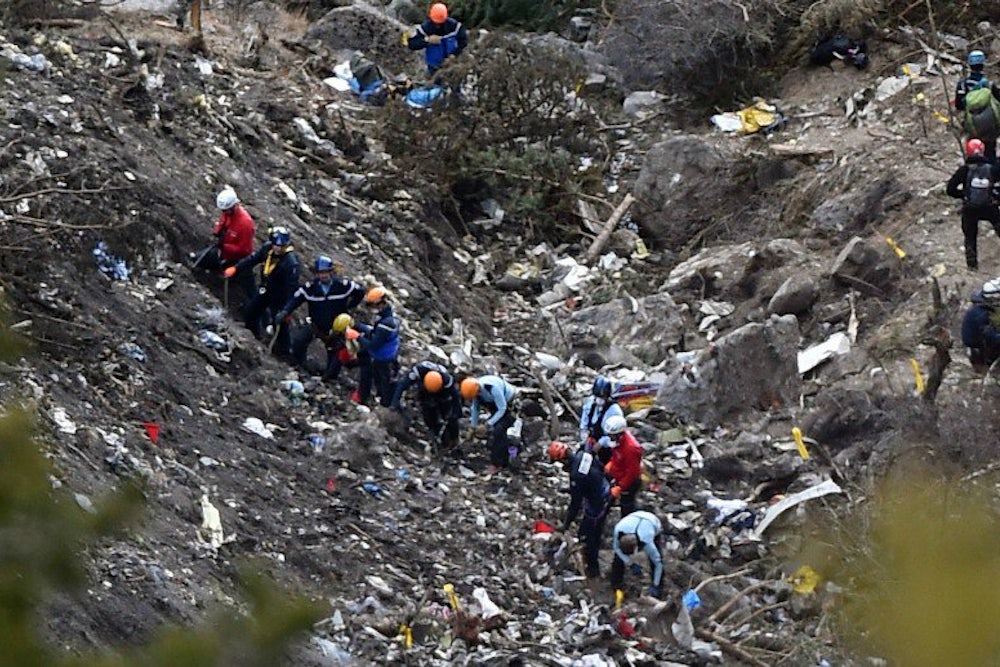On Tuesday, Germanwings flight 9525 crashed into the French Alps, killing 150 people. Today, French prosecutor Brice Robin claimed that based on the evidence from the cockpit voice recorder, co-pilot Andreas Lubitz deliberately crashed the airplane. According to the Guardian, Lufthansa—which owns Germanwings—confirmed that Lubitz “appeared to have prevented the captain from re-entering the cabin” after using the restroom. “It was a voluntary action,” said Robin, intended “to destroy the aircraft.”
Should this intentional crash theory prove true, the Germanwings flight will be added to the list of airplane crashes attributed to pilot suicide. Though far less common than accidental crashes, several have occurred over the last few decades. The most recent incident of this kind occurred in November 2013 when Mozambique Airlines Flight TM470 crashed in a remote area of Namibia. Reports suggested that—as reportedly occurred in the Germanwings incident—the pilot locked himself in the cockpit before taking down the plane.
Perhaps the most famous incident of alleged pilot suicide was EgyptAir Flight 990, which crashed off New England in 1999, killing 217 people. Though the account was strongly disputed by Egyptian authorities, evidence appeared to suggest that the co-pilot deliberately downed the plane. Many believe the same occurred with SilkAir flight 185 in Indonesia in 1997, which killed 104. In 1994, Royal Air Moroc flight 630 which crashed shortly after takeoff into Morocco’s Atlas Mountains in 1994, killing 44.
Reports on these crashes suggested that the pilots had experienced a range of personal problems. The Associated Press reported that the pilot of the ill-fated Namibian flight had been “very depressed” due to marital problems. Sources told the Guardian that Gamil el-Batouty, the co-pilot responsible for the downing of the EgyptAir flight, had been reprimanded over sexual misconduct allegations. They believe he crashed the plane to get revenge on the executive responsible for his demotion, who was present on the flight. The captain of the Silk Air flight had “experienced multiple work-related difficulties” and “significant financial difficulties” in the months leading up to the incident, according to the Aviation Safety Network.
Lufthansa chief executive Cartsen Spohr said Lubitz had passed all required psychological and physical tests necessary for training. Spohr also said there was an interruption of “a few months” in Lubitz’s training, though it’s unclear why. Robert Bor, an aviation psychologist, told the Guardian: “The very first thing the aviation authorities and investigators will do is go through his personal background and look at his professional life, in terms of his relationships, finances, flying record and medical record.”
There’s something else that most of these incidents have in common: the pilot locked out all other flight crew before crashing the plane. Since 9/11, it has become common for cockpit doors to be locked, but experts say that pilots are never to be left alone. “You ask any pilot, they’ll tell you the same thing,” Glen Winn, an aviation instructor at the University of Southern California and an expert in aviation security and anti-terrorism, told the Los Angeles Times. “They don’t leave a person alone in the cockpit. They don’t do it. Nobody does that.” But internationally, regulations appear to differ from U.S. rules. Lufthansa spokesman Waber Joerg told CNN that the “authorities and regulations stipulate that a pilot can be in the cockpit alone,” though they recommend this “time be kept to a minimum.”
